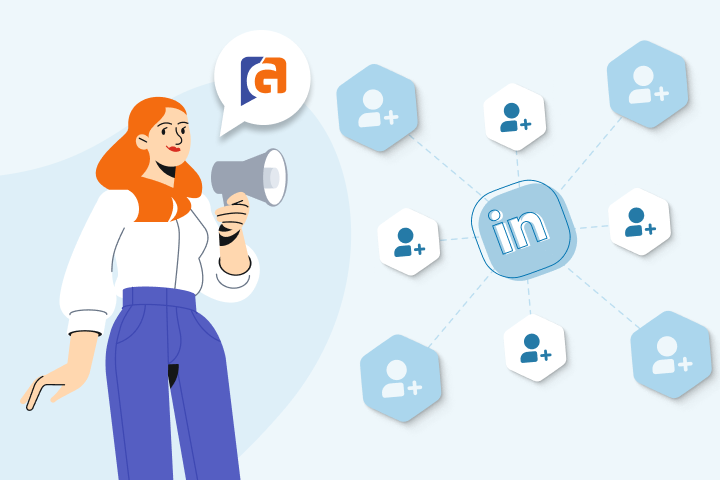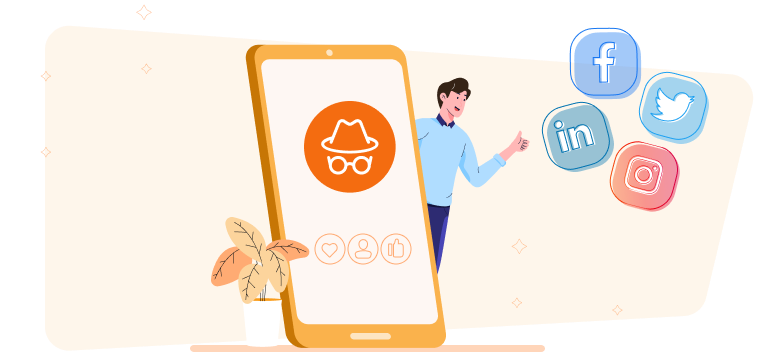Social Media Marketing LinkedIn: Strategies To Build an Audience
If you’re a B2B company and aren’t fully leveraging LinkedIn to connect with prospects and customers, you could be leaving money on the table. 96% of B2B marketers use LinkedIn, and 60% say that it’s very or extremely effective, beating out top B2B marketing channels like Facebook, Twitter, and YouTube.
Where else can you find your target audience by job title, interests, and location and deliver them custom messages? Whether you’re just getting started or aiming to grow your engagement, follow these tips to unlock your full potential on LinkedIn.
How To Create a LinkedIn B2B Strategy
The most important takeaway about LinkedIn is that it’s relational. Communication is a two-way street: what your audience can learn from you and what you can learn from your audience.
To succeed on LinkedIn, you need to build an audience and keep their interest with valuable content, transparency, and insights that they can’t find elsewhere. Don’t try to transfer your approach from other B2B marketing channels like Facebook or Google Ads directly to LinkedIn — it won’t work. Instead, follow these steps to uncover the best LinkedIn B2B marketing strategies for your business.
Define Your Goals
Before jumping into tactics, define your goals for investing in LinkedIn. Is it lead generation, building brand awareness, or thought leadership? Are you trying to drive a specific action (e.g., event registrations)?
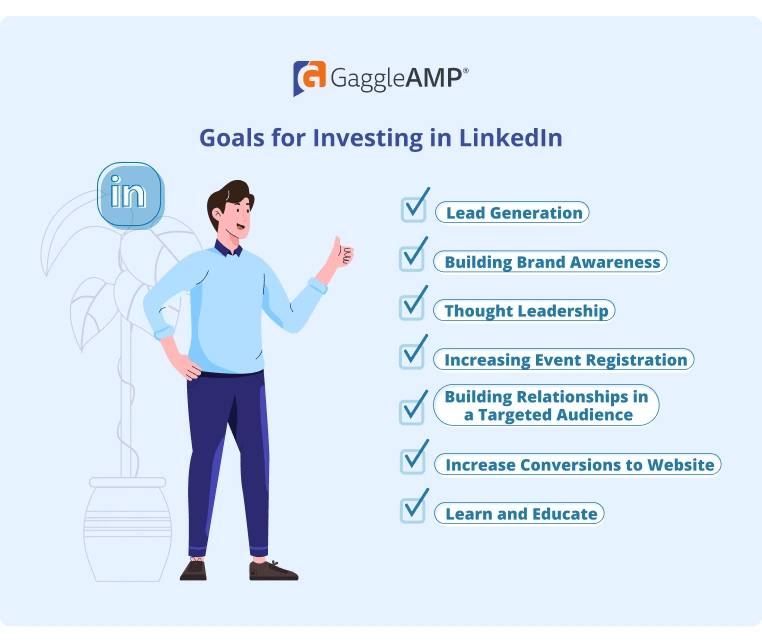
Defining your long-term and short-term goals will help you set your budget and set realistic expectations for what your LinkedIn B2B marketing can accomplish.
Understand Your Audience
LinkedIn is a great research tool. You can find out your target audience’s career and educational background, discover what groups they’re active in, and uncover their pain points through their posts (and comments).
Here are five ways to learn more about your audience on LinkedIn.
-
Follow industry leaders and key customers on LinkedIn.
-
Join relevant groups as a listener and contributor. (Your goal in groups isn’t to make a sales pitch!)
-
Create buyer personas. Ask yourself why your target audience is using LinkedIn: Is it for personal networking, sales, education, etc.?
-
Use your follower analytics to learn more about your audience.
-
Create a survey or poll to ask your audience questions.
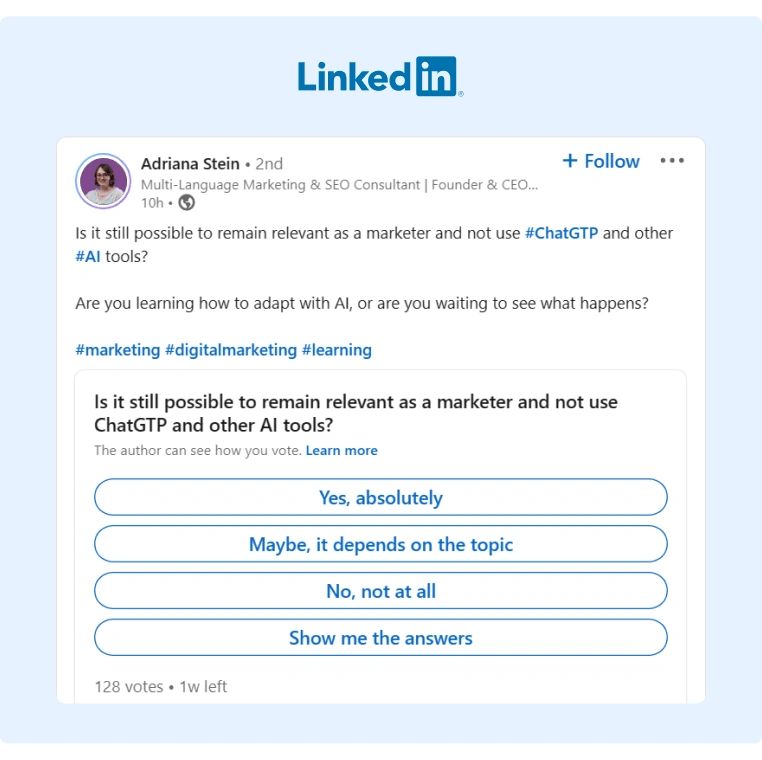
Building a relationship takes time. By listening and engaging, you can discover your audience’s category entry points — their pain points and motivators that can help you sell.
Create an Engagement Strategy
Now that you have these crucial two pieces of information — your goals and your audience’s goals — you’re ready to create an engagement strategy. Your goals should inform the marketing mix that you use. If your top goal is LinkedIn B2B lead generation, consider an investment in short-term tactics such as outbound prospecting and an ad campaign to drive leads directly through the platform.
If your goal is brand awareness and thought leadership, make organic content your top priority. Create a content calendar, identify leaders to create content, and invest in resources like video production and graphic design. You can also run paid campaigns with the goal of building more followers.
Your engagement strategy should include outlines for:
- How often you’ll post and what type of content you’ll share.
- Plans for driving and sharing user-generated content, like an employee advocacy program.
- Your budget for any paid ads and the messaging and goals for them.
- Your plans for outbound prospecting: who will do it and what the messaging will be.
How To Generate B2B Leads on LinkedIn
There are multiple ways to generate B2B leads on LinkedIn, and each has its unique purpose. The first is by running an ad campaign. You can run paid campaigns that either collect leads within the platform (with actions like booking a demo or downloading an e-book), or by sending users to a landing page on your website. This tactic can be effective in the short-term, but doesn’t build a long-term audience.
The second way is through outbound prospecting — having your sales team reach out to prospects directly through messaging. This can be very targeted and effective, but it can also be time-intensive for the sales team and should be planned with care and intention.
Finally, another way you can generate B2B leads is by posting organic content. While it’s tempting to only post about your products or services, experts recommend that you follow the 4-1-1 rule:
- 4 New Content Posts. Share a valuable blog post or resource that would be relevant to your audience.
- 1 Repost. Retweet or share posts from other social media users with your audience.
- 1 Self-Serving Post. Share posts that promote your business.
By building value and trust, you’ll make your self-serving posts all the more effective in driving traffic and leads.
Types of B2B Marketing on LinkedIn
Before you start creating content, you first need to understand the types of content that resonate on LinkedIn. Let’s look at organic content on LinkedIn, Linkedin paid ads, and outbound prospecting with LinkedIn messaging.
1. Organic Content on LinkedIn
Posts on LinkedIn without any paid support behind them are considered organic content. These can be text, image, or video posts that are published on a company page, on an individual profile, or in a group. The views and engagement these posts receive are from the value of the content itself and the strength of the LinkedIn user’s existing connections. The more users that interact with a post, the more their connections will see the post — hence the name organic growth.
2. LinkedIn Paid Ads
LinkedIn also offers paid advertising options for companies wanting to build up an audience from scratch or to promote a specific call to action. These LinkedIn statistics speak to the value of paid social campaigns:
- 78% of B2B marketers have run LinkedIn B2B ads in the past year.
- 89% of B2B marketers using paid social say LinkedIn ad campaigns are effective in helping them reach their content marketing goals.
Sponsored posts look just like organic posts but use ad dollars to boost the post into more feeds, including the feeds of those who aren’t yet connections or followers. Other ad types like text ads, message ads, and dynamic ads resemble more traditional pay per click ads and appear in places like LinkedIn’s right rail, top banner, or LinkedIn messaging.
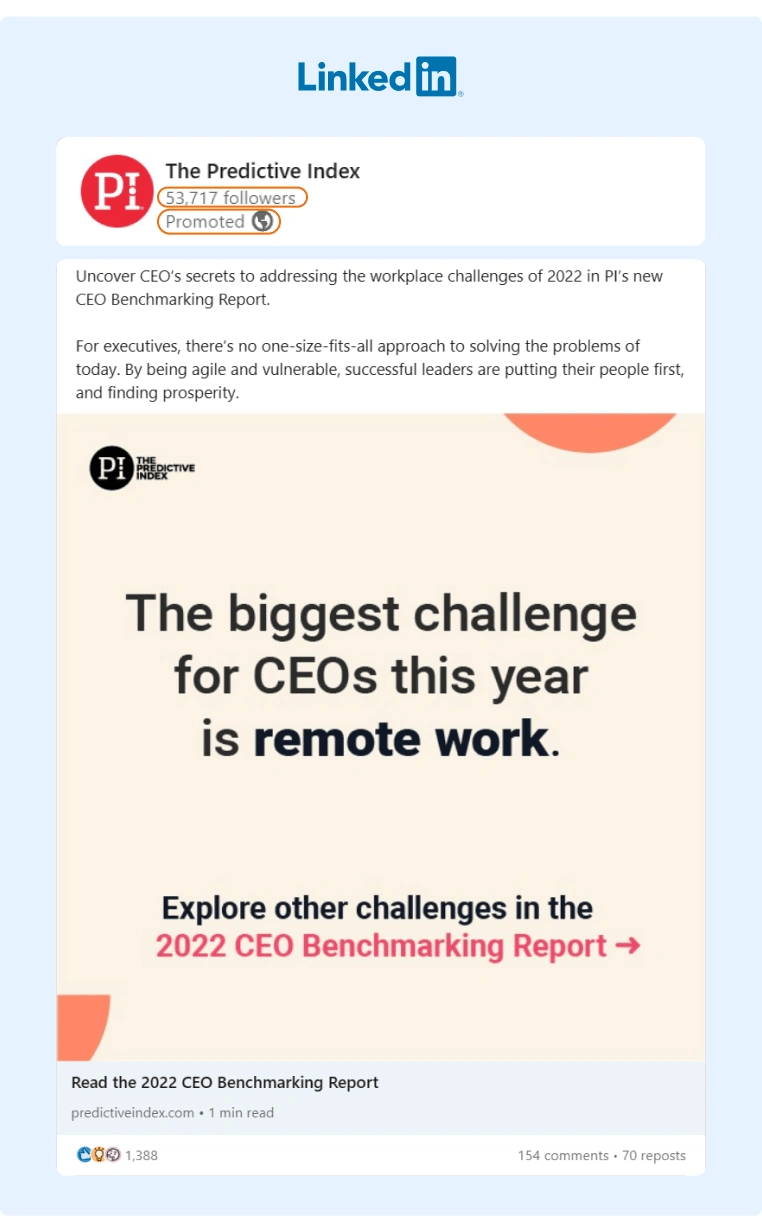
To tell the difference between organic content and paid ads, look for the tag ‘promoted’ under the company name.
3. Outbound Prospecting With LinkedIn Messaging
Many companies use LinkedIn for direct outreach, like recruitment or B2B sales. Since LinkedIn has a vast network with advanced search tools, companies can target professionals that meet specific criteria and start direct conversations with them inside the platform.
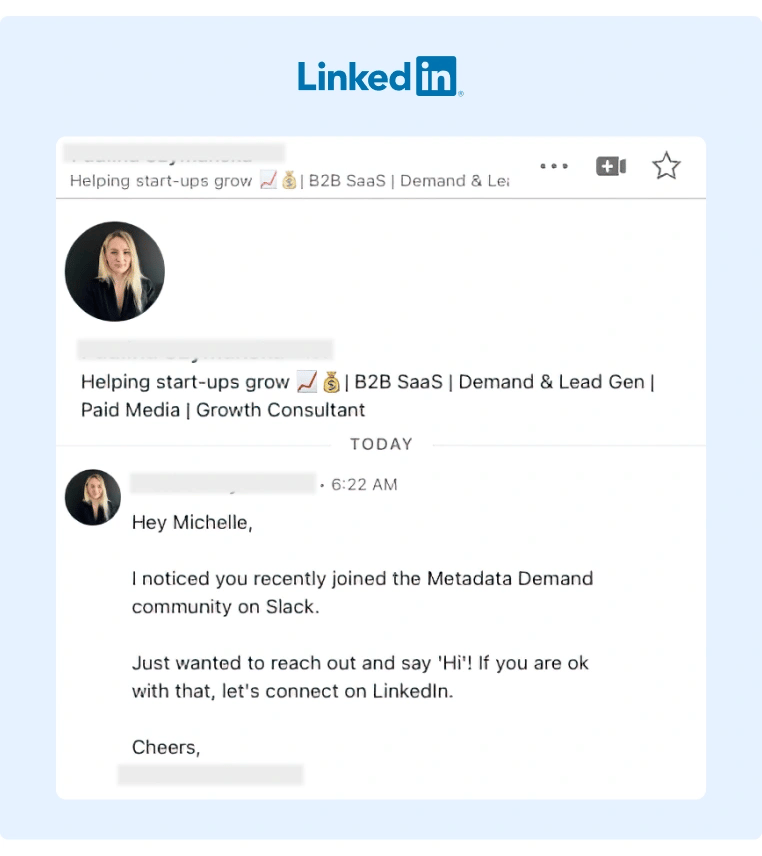
B2B Marketing Campaign Examples on LinkedIn
According to LinkedIn, the best content snags users’ attention in 150 characters or less. That means that every word counts. Browse these organic and ad campaign examples from top brands on LinkedIn for winning B2B marketing examples. Let’s start with organic campaign examples.
Organic LinkedIn Campaign Examples
Need some inspiration? Fuel your creativity with these posts from the best B2B marketing campaigns on LinkedIn.
Salesforce: Behind the Scenes Post
Did you know that posts with images receive more than twice as many views than text-only posts? Here, Salesforce posts some simple team engagement photos, humanizing the brand.
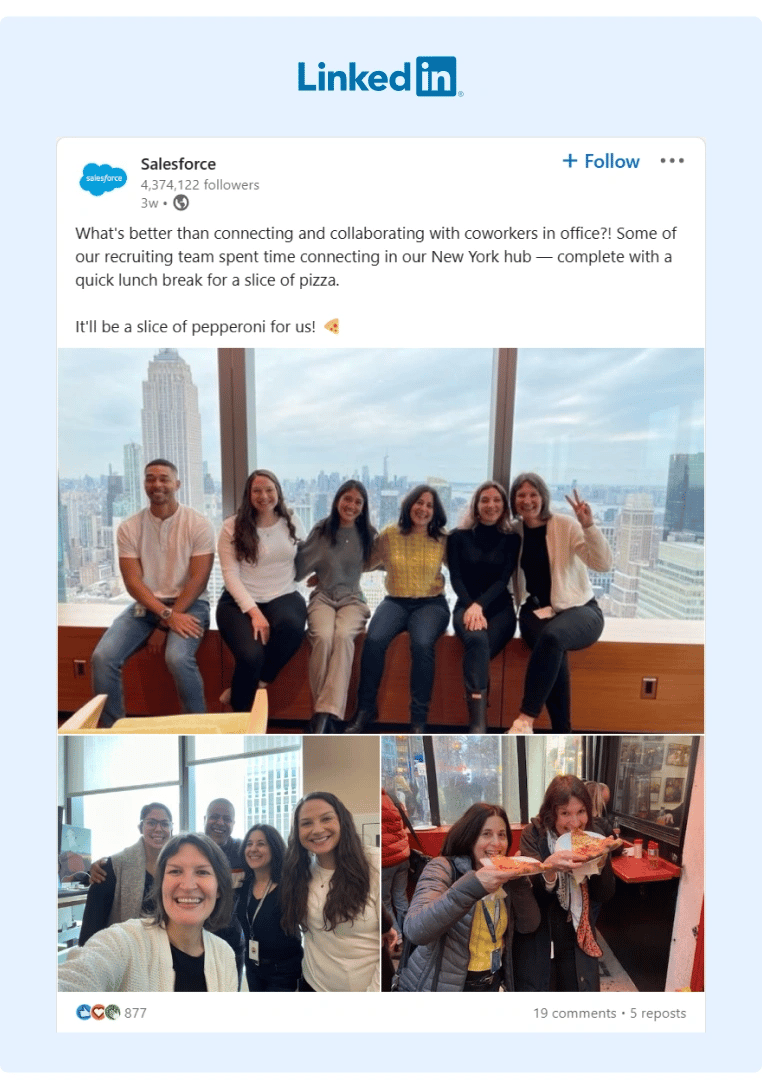
Source: Salesforce
Accenture: Trends Poll Post
Here, consulting firm Accenture engages its followers with a quick poll about trends that their followers are excited about. This is part of a campaign centered around #AccentureLifeTrends. While fun and informative, they also slide in a CTA for their audience to download a relevant report.
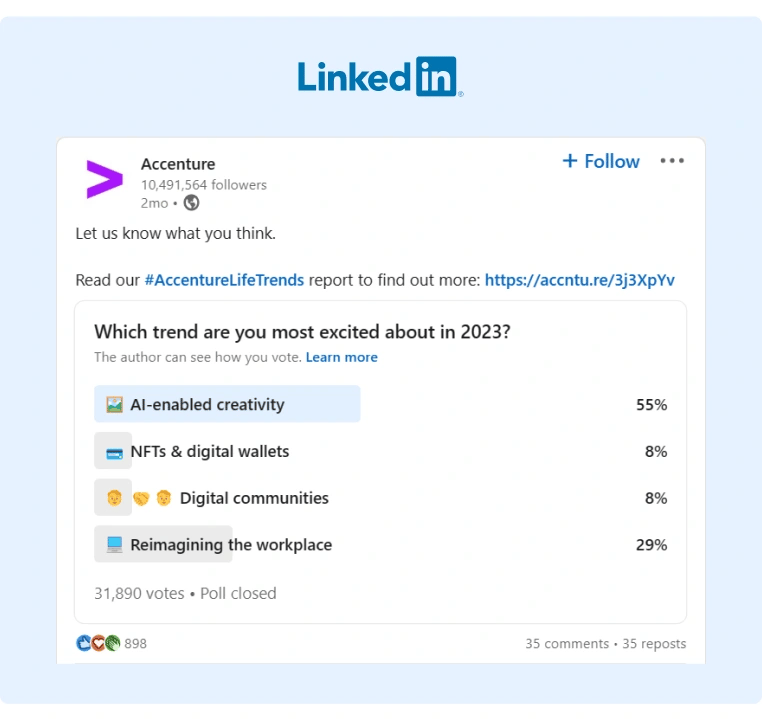
Source: Accenture
Indeed: Layoff Tips Post
In this post, you see images with key tips for laid-off professionals. While this post doesn’t sell their product or speak to their core B2B audience of employers, it adds value (through the ongoing campaign #IndeedHelps) and drives conversation within their industry.
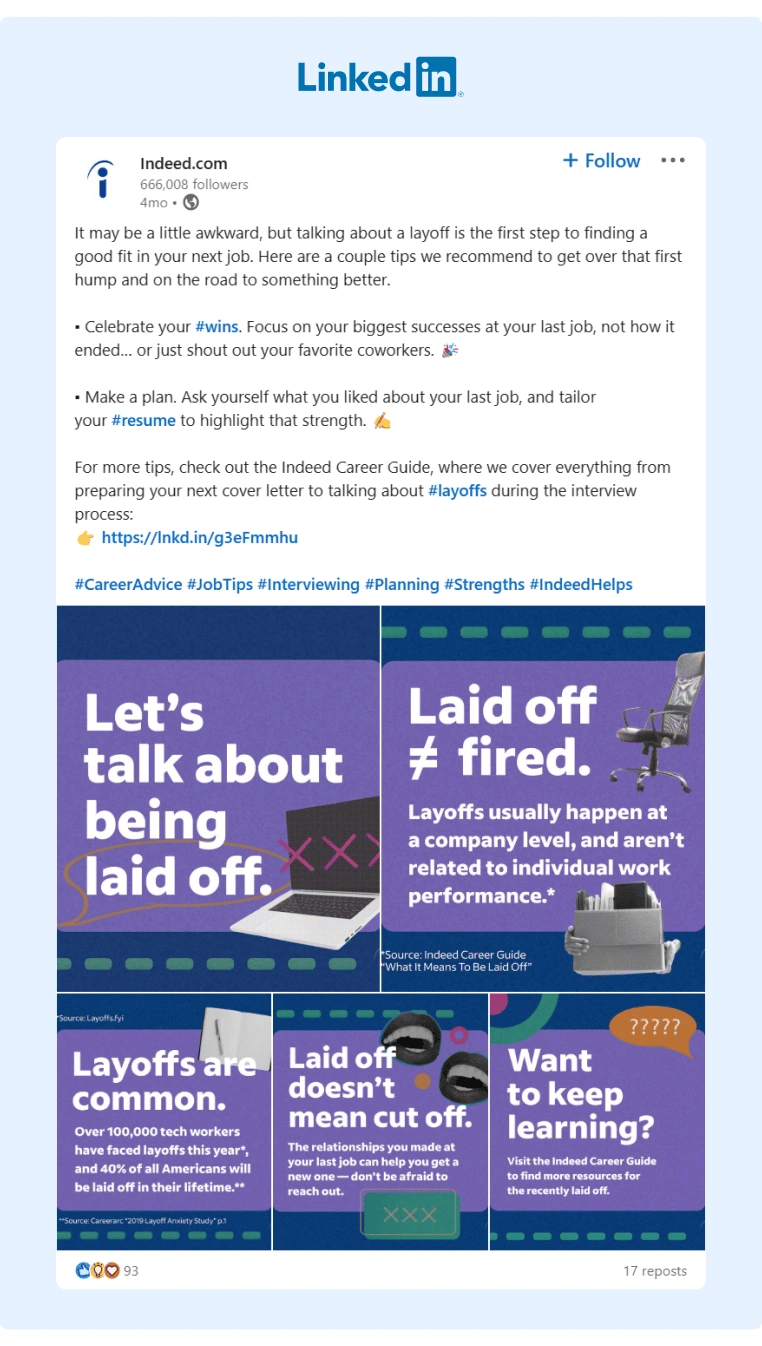
Source: Indeed
Ad Campaign B2B Examples
If you have a personal LinkedIn account, scroll through your feed and pay attention to the B2B marketing campaigns examples, focusing on sponsored posts and ads. Next, take notes from the best LinkedIn campaigns featured below.
Dell Technologies: Whitepaper Campaign
A whitepaper, report, or other types of lead magnets can be a great tool to generate B2B leads like this campaign from Dell Technologies.
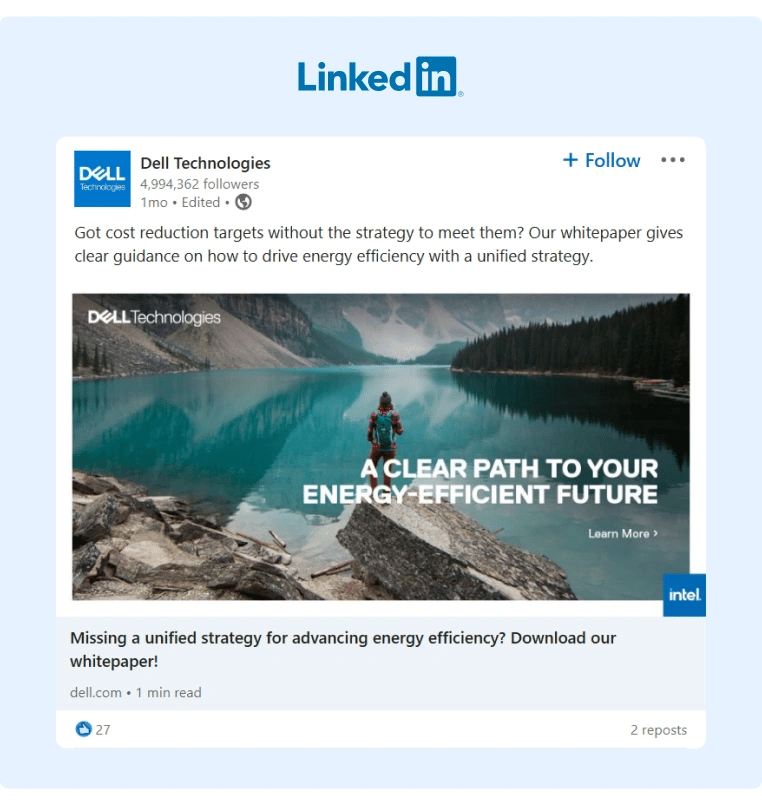
Source: Dell Technologies
Notion: Video Ad
With just two lines of text and a 20-second video, Notion presses into readers’ pain points and proposes that there’s a better way.
Source: Notion
LinkedIn B2B Marketing Trends 2023
LinkedIn has been rolling out new formats and ways to engage with users. Here are two trending formats that you should try in 2023.
Carousels
An image carousel allows you to add multiple images (or videos) to a single post that users can view by swiping across them. Content creators are using this in all kinds of creative ways. Of course, some are using it simply for photos.
Some content creators are using carousels to post embedded content on images such as a tip roundup. Rather than having all of their text in the post, they have a short intro in the post and include a visual tip on each image. Take a look at this post from The Mom Project as an example.
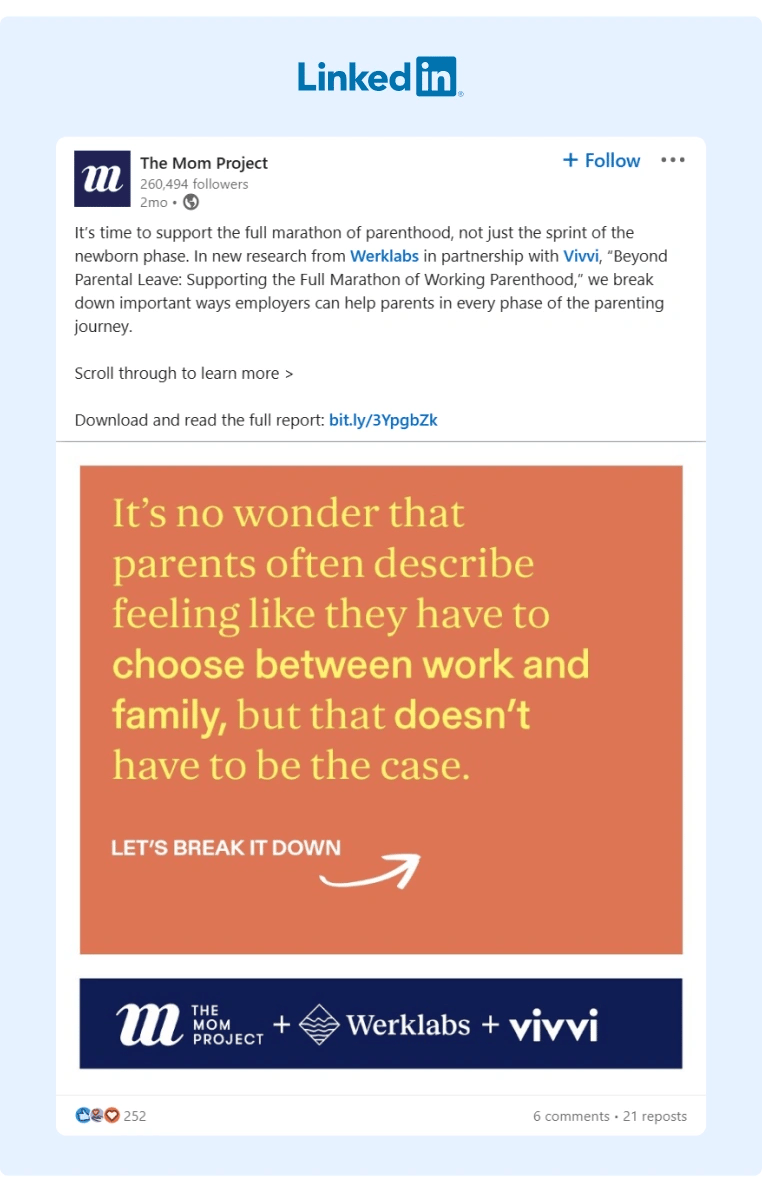
Source: The Mom Project
Live Video
Video is one of the best formats you can use on LinkedIn because of its visual appeal and storytelling ability. B2B marketers rated virtual events the second most effective content type in 2023.
Now, instead of just posting recorded videos, you can host live videos and manage event registration through LinkedIn. Check out this example video from Accenture, who produced a livestream at a top industry event.
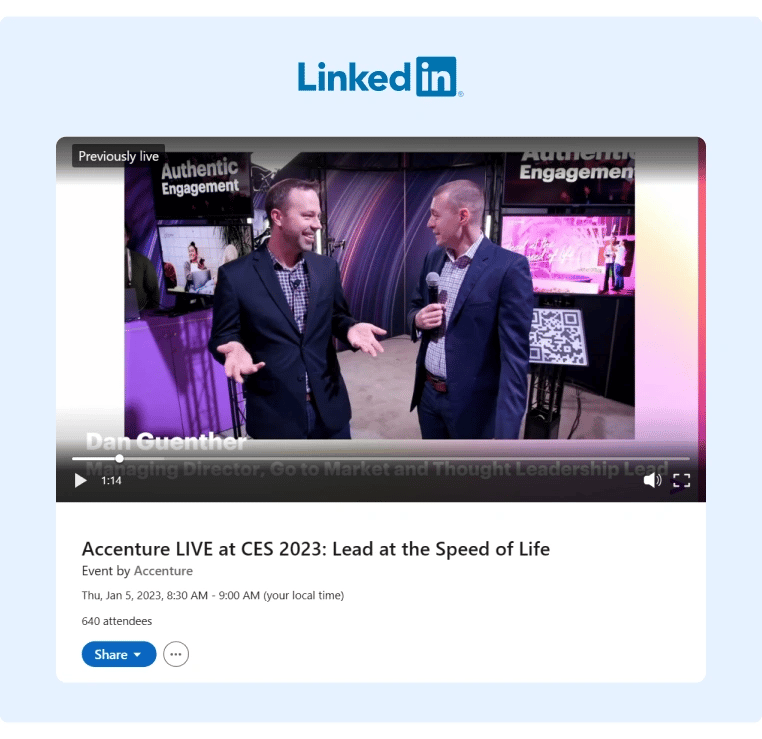
Source: Accenture
How To Get Started With B2B Marketing on LinkedIn
So, you’ve researched your audience. You’ve determined your strategy. Now, it’s time to start making magic.
1. Create Your LinkedIn Page
If your company doesn’t already have a LinkedIn page, start by setting one up. First, you’ll need a personal LinkedIn account to serve as an administrator. Next, add your company’s logo, organizational info, and company overview.
In your company overview, include your company’s purpose and relevant keywords and phrases so that you’ll appear in searches and catch a reader’s attention. Lastly, be sure to make your profile pop with an eye-catching custom banner and tagline.
2. Optimize Your LinkedIn Page
Once you’ve created the bare bones of a company page, roll your sleeves up for round two. If you’re taking over (or overhauling) an existing LinkedIn page, this is the perfect place to step in and see where you can improve.
Here are a few ways you can strengthen and optimize your pages:
- Drive Conversions With Custom CTA(s). Add your CTA(s) below your header (e.g., contact us, register, or visit website).
- Add Product Pages. Use these pages to highlight the different products that your company offers.
- Create Showcase Pages. Spotlight sub-brands, business units, and initiatives within your company.
3. Post Consistently
Focus on consistently posting organic content. Even if ads or messaging make up a large part of your strategy, you can’t attract followers or leads without consistent and thoughtful organic posts, too.
Also, engage with comments on your posts, and follow and comment on others’ pages and posts to build an audience that you can turn into leads and referrals.
4. Incentivize Your Employees to Post Content
On average, employees have 10x the connections their company does on LinkedIn. Employees can share your content with their connections, increasing your brand reach. But how do you get your employees to share your content?
One way is through an employee advocacy program where you write and share content or prompts to make it easy for employees to post on LinkedIn. An employee advocacy tool can help to track engagement and save time when you roll out a program at scale.
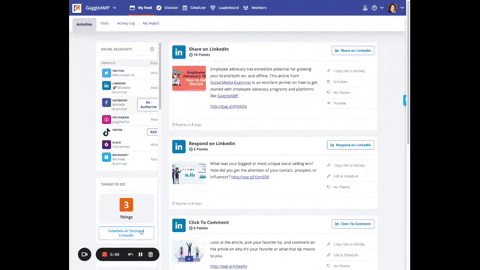
Another approach you can take is to build a thought leadership platform with your CEO or other select leaders. Due to the nuanced level of messaging and executives’ busy schedules, consider collaborating to ghostwrite their content or even managing their social media profiles for them.
5. Measure Your B2B LinkedIn Campaigns
To monitor your progress and improve your organic engagement, keep an eye on your LinkedIn analytics. Your content analytics will show you which content is resonating best with your audience and how you can improve. These include:
- Impressions. How many times someone has viewed your content.
- Reactions, Comments and Shares. How often users engage with your post.
- Clicks. The number of clicks on your content or profile from a post.
- Engagement Rate. Shows your engagement relative to the number of impressions you receive — a great metric to watch even if you’re starting with a tiny audience.
To track lead generation from LinkedIn, use campaign links to track your traffic and leads with precision in Google Analytics.
Harness the Power of B2B on LinkedIn
There’s a reason why LinkedIn is a top B2B distribution channel example: marketers love that you can share videos, posts, and multimedia content and collect leads directly from the platform. Just don’t forget that it’s a relational tool first and foremost, and you’ll find success.
And if you want a tool to help streamline your employee advocacy strategy and keep your employees actively engaged, consider using GaggleAMP. Request a demo today!






